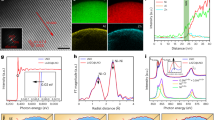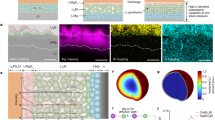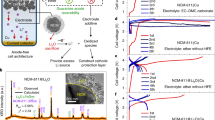Abstract
Rechargeable lithium–air (O2) batteries are receiving intense interest because their high theoretical specific energy exceeds that of lithium-ion batteries. If the Li–O2 battery is ever to succeed, highly reversible formation/decomposition of Li2O2 must take place at the cathode on cycling. However, carbon, used ubiquitously as the basis of the cathode, decomposes during Li2O2 oxidation on charge and actively promotes electrolyte decomposition on cycling. Replacing carbon with a nanoporous gold cathode, when in contact with a dimethyl sulphoxide-based electrolyte, does seem to demonstrate better stability. However, nanoporous gold is not a suitable cathode; its high mass destroys the key advantage of Li–O2 over Li ion (specific energy), it is too expensive and too difficult to fabricate. Identifying a suitable cathode material for the Li–O2 cell is one of the greatest challenges at present. Here we show that a TiC-based cathode reduces greatly side reactions (arising from the electrolyte and electrode degradation) compared with carbon and exhibits better reversible formation/decomposition of Li2O2 even than nanoporous gold (>98% capacity retention after 100 cycles, compared with 95% for nanoporous gold); it is also four times lighter, of lower cost and easier to fabricate. The stability may originate from the presence of TiO2 (along with some TiOC) on the surface of TiC. In contrast to carbon or nanoporous gold, TiC seems to represent a more viable, stable, cathode for aprotic Li–O2 cells.
This is a preview of subscription content, access via your institution
Access options
Subscribe to this journal
Receive 12 print issues and online access
$259.00 per year
only $21.58 per issue
Buy this article
- Purchase on Springer Link
- Instant access to full article PDF
Prices may be subject to local taxes which are calculated during checkout





Similar content being viewed by others
References
Scrosati, B., Hassoun, J. & Sun, Y. K. Lithium-ion batteries. A look into the future. Energy Environ. Sci. 4, 3287–3295 (2011).
Christensen, J. et al. A critical review of Li/air batteries. J. Electrochem. Soc. 159, R1–R30 (2012).
Bruce, P. G., Freunberger, S. A., Hardwick, L. J. & Tarascon, J-M. Li–O2 and Li-S batteries with high energy storage. Nature Mater. 11, 19–29 (2012).
Black, R., Adams, B. & Nazar, L. F. Non-aqueous and hybrid Li–O2 batteries. Adv. Energy Mater. 2, 801–815 (2012).
Shao, Y. et al. Electrocatalysts for nonaqueous lithium–air batteries: Status, challenges, and perspective. ACS Catal. 2, 844–857 (2012).
Garcia-Arae, N. & Novák, P. Critical aspects in the development of lithium–air batteries. J. Solid State. Electrochem. 17, 1793–1807 (2013).
Girishkumar, G., McCloskey, B., Luntz, A. C., Swanson, S. & Wilcke, W. Lithium–ir battery: Promise and challenges. J. Phys. Chem. Lett. 1, 2193–2203 (2010).
Lu, Y-C. et al. Lithium–oxygen batteries: Bridging mechanistic understanding and battery performance. Energy Environ. Sci. 6, 750–768 (2013).
Choi, N. S. et al. Challenges facing lithium batteries and electrical double-layer capacitors. Angew. Chem. Int. Ed. 51, 9994–10024 (2012).
Zhang, T., Imanishi, N., Takeda, Y. & Yamamoto, O. Aqueous lithium/air rechargeable batteries. Chem. Lett. 40, 668–673 (2011).
Abraham, K. M. & Jiang, Z. A polymer electrolyte-based rechargeable lithium/oxygen battery. J. Electrochem. Soc. 143, 1–5 (1996).
Ogasawara, T., Debart, A., Holzapfel, M., Novak, P. & Bruce, P. G. Rechargeable LI2O2 electrode for lithium batteries. J. Am. Chem. Soc. 128, 1390–1393 (2006).
Peled, E., Golodnitsky, D., Mazor, H., Goor, M. & Avshalomov, S. Parameter analysis of a practical lithium- and sodium-air electric vehicle battery. J. Power Sources 196, 6835–6840 (2011).
Hartmann, P. et al. A rechargeable room-temperature sodium superoxide (NaO2) battery. Nature Mater. 12, 228–232 (2013).
McCloskey, B. B., Bethune, D. S., Shelby, R. M., Girishkumar, G. & Luntz, A. C. Solvents’ critical role in nonaqueous lithium–oxygen battery electrochemistry. J. Phys. Chem. Lett. 2, 1161–1166 (2011).
Freunberger, S. A. et al. The lithium-oxygen battery with ether-based electrolytes. Angew. Chem. Int. Ed. 50, 8609–8613 (2011).
Xu, W. et al. The stability of organic solvents and carbon electrode in nonaqueous Li–O2 batteries. J. Power Sources 215, 240–247 (2012).
Zhengcheng, Z. et al. Increased stability toward oxygen reduction products for lithium–air batteries with oligoether-functionalized silane electrolytes. J. Phys. Chem. C 115, 25535–25542 (2011).
Guo, Z., Zhu, G., Qiu, Z., Wang, Y. & Xia, Y. High performance Li–O2 battery using γ-MnOOH nanorods as a catalyst in an ionic-liquid based electrolyte. Electrochem. Commun. 25, 26–29 (2012).
McCloskey, B. D. et al. Twin problems of interfacial carbonate formation in nonaqueous Li–O2 batteries. J. Phys. Chem. Lett. 3, 997–1001 (2012).
Gallant, B. M. et al. Chemical and morphological changes of Li–O2 battery electrodes upon cycling. J. Phys. Chem. C 116, 20800–20805 (2012).
Ottakam Thotiyl, M. M., Freunberger, S. A., Peng, Z. & Bruce, P. G. The carbon electrode in non-aqueous Li–O2 cells. J. Am. Chem. Soc. 135, 494–500 (2013).
Sharon, D. et al. On the challenge of electrolyte solutions for Li–air batteries: Monitoring oxygen reduction and related reactions in polyether solutions by spectroscopy and EQCM. J. Phys. Chem. Lett. 4, 127–131 (2013).
Tsiouvaras, N., Meini, S., Buchberger, I. & Gasteiger, H. A. A novel on-line mass spectrometer design for the study of multiple charging cycles of a Li–O2 battery. J. Electrochem. Soc. 160, A471–A477 (2013).
Chen, Y., Freunberger, S. A., Peng, Z., Barde, F. & Bruce, P. G. Li–O2 battery with a dimethylformamide electrolyte. J. Am. Chem. Soc. 134, 7952–7957 (2012).
Peng, Z., Freunberger, S. A., Chen, Y. H. & Bruce, P. G. A reversible and higher-rate Li–O2 battery. Science 337, 563–566 (2012).
Bryantsev, V. et al. The identification of stable solvents for nonaqueous rechargeable Li-air batteries. J. Electrochem. Soc. 160, A160–A171 (2013).
Mo, Y., Ong, S. P. & Ceder, G. First-principles study of the oxygen evolution reaction of lithium peroxide in the lithium–air battery. Phys. Rev. B 84, 205446–205454 (2011).
Radin, M. D., Rodriguez, J. F., Tian, F. & Siegel, D. J. Lithium peroxide surfaces are metallic, while lithium oxide surfaces are not. J. Am. Chem. Soc. 134, 1093–1103 (2012).
Bryantsev, V. et al. Predicting solvent stability in aprotic electrolyte Li–air batteries: Nucleophilic substitution by the superoxide anion radical (O2·−). J. Phys. Chem. A 115, 12399–12409 (2011).
Xu, D. et al. A stable sulfone based electrolyte for high performance rechargeable Li–O2 batteries. Chem. Commun. 48, 11674–11676 (2012).
Walker, W. et al. A rechargeable Li–O2 battery using a lithium nitrate/N,N-dimethylacetamide electrolyte. J. Am. Chem. Soc. 135, 2076–2079 (2013).
Younesi, R. et al. Ether based electrolyte, LiB(CN)4 salt and binder degradation in the Li–O2 battery studied by hard X-ray photoelectron spectroscopy (HAXPES). J. Phys. Chem. C 116, 18597–18604 (2012).
Mizuno, F., Nakanishi, S., Kotani, Y., Yokoishi, S. & Iba, H. Rechargeable Li-air batteries with carbonate-based liquid electrolytes. Electrochemistry 78, 403–405 (2010).
Freunberger, S. A. et al. Reactions in the rechargeable lithium-O2 battery with alkyl carbonate electrolytes. J. Am. Chem. Soc. 133, 8040–8047 (2011).
Kim, J., Lee, J. & Tak, Y. Relationship between carbon corrosion and positive electrode potential in a proton-exchange membrane fuel cell during start/stop operation. J. Power Sources 192, 674–678 (2009).
Laoire, C. O., Mukerjee, S., Abraham, K. M., Plichta, E. J. & Hendrickson, M. A. Influence of nonaqueous solvents on the electrochemistry of oxygen in the rechargeable lithium–air battery. J. Phys. Chem. C 114, 9178–9186 (2010).
Trahan, M. J., Mukerjee, S., Plichta, E. J., Hendrickson, M. A. & Abraham, K. M. Studies of Li-air cells utilizing dimethyl sulfoxide-based electrolyte. J. Electrochem. Soc. 160, A259–A267 (2013).
Xu, D., Wang, Z-L., Xu, J-J., Zhang, L-L. & Zhang, X-B. Novel DMSO-based electrolyte for high performance rechargeable Li–O2 batteries. Chem. Commun. 48, 6948–6950 (2012).
Jung, H. G., Hassoun, J., Park, J. B., Sun, Y. K. & Scrosati, B. An improved high-performance lithium–air battery. Nature Chem. 4, 579–585 (2012).
Black, R, Lee, J-H., Adams, B., Mims, C. A. & Nazar, L. F. The role of catalysts and peroxide oxidation in lithium–oxygen batteries. Angew. Chem. Int. Ed. 52, 392–396 (2013).
Oh, S. H., Black, R., Pomerantseva, E., Lee, J-H. & Nazar, L. F. Synthesis of a metallic mesoporous pyrochlore as a catalyst for Li–O2 batteries. Nature Chem 4, 1004–1010 (2012).
Hassoun, J. et al. A metal-free, lithium-ion oxygen battery: A step forward to safety in lithium–air batteries. Nano Lett. 12, 5775–5779 (2012).
Andersson, A. S. & Thomas, J. O. The source of first-cycle capacity loss in LiFePO4 . J. Power Sources 97–98, 498–502 (2001).
Padhi, A. K., Nanjundaswany, K. S., Masquelier, C., Okada, S. & Goodenough, J. B. Effect of structure on the Fe3+/Fe2+ redox couple in iron phosphates. J. Electrochem. Soc. 144, 1609–1613 (1997).
Qi, Y. & Harris, S. J. In situ observation of strains during lithiation of a graphite electrode. J. Electrochem. Soc. 157, A741–A747 (2010).
Vetter, J. et al. Ageing mechanisms in lithium-ion batteries. J. Power Sources 147, 269–281 (2005).
Dahn, J. R. Phase diagram of LixC6 . Phys. Rev. B 44, 9170–9177 (1991).
Larcher, D. et al. Recent findings and prospects in the field of pure metals as negative electrodes for Li-ion batteries. J. Mater. Chem. 17, 3759–3772 (2007).
Zhong, L. et al. In situ transmission electron microscopy observations of electrochemical oxidation of Li2O2 . Nano Lett. 13, 2209–2214 (2013).
Shackelford, J. F. & Alexander, W. Materials Science and Engineering Handbook 3 edn, Ch. 7 (CRC, 2001).
Li, F. et al. Carbon supported TiN nanoparticles: An efficient bifunctional catalyst for non-aqueous Li–O2 batteries. Chem. Commun. 49, 1175–1177 (2013).
Mitchell, R. R., Gallant, B. M., Shao-Horn, Y. & Thompson, C. V. Mechanisms of morphological evolution of Li2O2 particles during electrochemical growth. J. Phys. Chem. Lett. 4, 1060–1064 (2013).
Adams, B. D. et al. Current density dependence of peroxide formation in the Li–O2 battery and its effect on charge. Energy. Environ. Sci. 6, 1772–1778 (2013).
Chen, Y., Freunberger, S. A., Peng, Z., Fontaine, O. & Bruce, P. G. Charging a Li–O2 battery using a redox mediator. Nature Chem. 5, 489–494.
Acknowledgements
P.G.B. is indebted to the EPSRC including the SUPERGEN programme for financial support. The authors thank S. Francis of the surface science group, St Andrews University for the XPS data.
Author information
Authors and Affiliations
Contributions
M.M.O.T. carried out experiments. P.G.B. wrote the manuscript. All authors contributed to the discussion and interpretation of the results.
Corresponding author
Ethics declarations
Competing interests
The authors declare no competing financial interests.
Supplementary information
Supplementary Information
Supplementary Information (PDF 2660 kb)
Rights and permissions
About this article
Cite this article
Ottakam Thotiyl, M., Freunberger, S., Peng, Z. et al. A stable cathode for the aprotic Li–O2 battery. Nature Mater 12, 1050–1056 (2013). https://doi.org/10.1038/nmat3737
Received:
Accepted:
Published:
Issue Date:
DOI: https://doi.org/10.1038/nmat3737
This article is cited by
-
The Linkage Between Electro-Chemical Mechanical Instabilities in Battery Materials
JOM (2024)
-
Roadmap for rechargeable batteries: present and beyond
Science China Chemistry (2024)
-
MXene/Ni foam supported Co-doped Ni3S2 as a binder-free electrode for enhanced performance of supercapacitors
Journal of Solid State Electrochemistry (2023)
-
Lithium-ion modified cellulose as a water-soluble binder for Li-O2 battery
Frontiers in Energy (2022)
-
Defect-induced deposition of manganese oxides on hierarchical carbon nanocages for high-performance lithium-oxygen batteries
Nano Research (2022)



